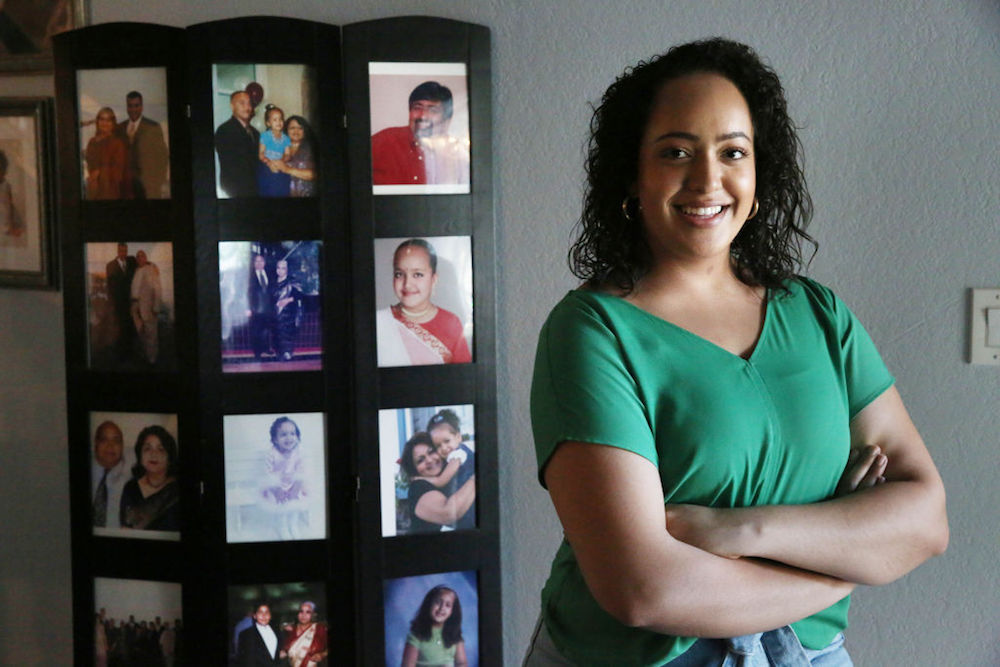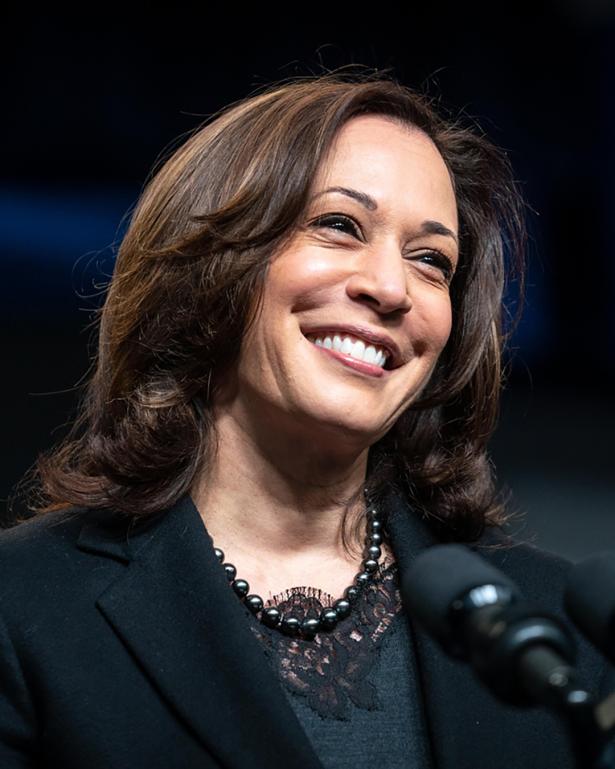When Kamala Devi Harris was sworn in as vice president earlier this year, many people in the U.S. and around the globe recognized that gender and racial barriers were being broken. But they didn’t necessarily agree on what those racial barriers were.
That’s because Harris does not fit neatly into the racial categories that U.S. society has set up.
Many in the U.S. heralded her as the first Black woman to be vice president.
But Harris also made history as the first person of Asian descent to become vice president. “Kamala Harris’ story is the story of a changing, inclusive America,” said Neil Makhija, the executive director of IMPACT, an Indian American advocacy group, when Biden first announced Harris as his pick for VP. “At a time of rapid change, she ties all our national threads together.”
While many in the South Asian community, both in the U.S. and in India, excitedly claimed Harris as an Indian American success story, some news outlets downplayed or ignored her Asian heritage. Throughout her political career, she has repeatedly been portrayed in the media as Black, first and foremost.
Why does her mixed identity matter to some people? It matters in a country such as the United States, which has based so much of its history implicitly and explicitly on racial identity—and especially on the separation of White identities from non-White identities.
“Don’t you let anyone tell you who you are. You tell them who you are.” - Dr. Shyamala Gopalan pic.twitter.com/8rs0sauN9E
— Maya Harris (@mayaharris_) August 12, 2020
Kamala Harris (left) stands with her sister, Maya, and their mother, Shyamala Gopalan, who immigrated to the U.S. from India.
This history goes back centuries. Anti-miscegenation statutes were first passed in the American colonies in the 1660s—before the U.S. had even declared independence from Britain. These statutes prohibited interracial marriage, with the aim of maintaining the “purity” of what became known as “White” bloodlines.
After the Civil War and into the early 20th century, as Black people who were formerly enslaved gained more civil rights, some White leaders in Southern states such as Arkansas and Virginia tried to maintain racial separations by passing laws stating that one drop of “Negro blood” made a person Black. The legacy of the law of hypodescent—or the “one-drop rule” as it has been called—was officially adopted by the U.S. census in 1930 and still lives on in practice today. It helps explain why people who are mixed race in the U.S. tend to be categorized as belonging to whatever group is ranked lower on the racial hierarchy.
I and other anthropologists have long understood that what we call “races” are invented categories based on variations in external appearances. Seen from that perspective, it’s clear that the one-drop rule was purely a social construct, not a biological one. It was designed to make sure that people with Black ancestry, no matter how White they looked, were considered Black and thus kept in an inferior position. It’s a clear reminder that while race is not biological, racism—and the belief that race is real—has devastating social, economic, and political consequences.
Given this history, it matters that Harris proudly claims she sees herself as both African American and South Indian. As an anthropologist who studies inequality, I see her self-identification as a repudiation of the one-drop rule and the unjust racial hierarchy it represents.
✽
As people in the U.S. watched Harris on the campaign trail—first as a potential Democratic presidential nominee and later as President Joe Biden’s running mate—they wanted to know about her background. Some reporters and pundits, accustomed to putting people in nice, neat categories, struggled with how to define her mixed heritage.
Rather than taking a reductionist view, which would require her to choose between identifying either as Black or Indian, Harris herself has chosen both—in large part due to her upbringing.
In her 2019 autobiography, The Truths We Hold: An American Journey, Harris writes extensively about growing up in the flatlands, a multiracial neighborhood in Berkeley, California, as the proud daughter of scientist Shyamala Gopalan. Harris has often talked in public about her close relationship with her mother, who died in 2009.
After immigrating to the U.S. from India at the age of 19, Gopalan met the man who would become Harris’ father, Donald Harris, a Jamaican immigrant, while attending graduate school in the early 1960s at the University of California, Berkeley. Both Gopalan and Donald Harris were involved in the Civil Rights movement sweeping the U.S.—and especially Berkeley—as intellectuals and activists who fought for social justice. Gopalan became a cancer researcher, while Donald Harris went on to get his Ph.D. in economics and teach at Stanford University.
“I am who I am,” Harris has said. “You might need to figure it out, but I’m fine with it.”
Harris and her sister, Maya, grew up in a progressive academic environment where they were taught to embrace the differences between people. After Gopalan and Donald Harris divorced in the early 1970s, Gopalan maintained custody. She relied on close friends and neighbors from their vibrant, diverse neighborhood to look after her girls while she was working in the lab or away on professional trips. On Sundays, they attended the Black church in their neighborhood. And they continued to be part of diverse communities, such as when Gopalan worked as a researcher in the multicultural city of Montreal.
As Harris described while on the campaign trail, Gopalan taught her daughters to be comfortable with both sides of their identities—proud of being Black in U.S. society and just as proud of their South Asian heritage. Gopalan seems to have understood that the U.S. was a place where only one drop of “Negro blood” made you Black, and she was determined to raise her daughters to celebrate both sides of their identity.
It takes a special kind of parent—in this case, an immigrant from a society that has its own institutionalized stratification system, the Hindu caste system in India—to recognize the racial stratification at the heart of U.S. society.
Gopalan herself was a trailblazer. Even though she came from a privileged upper-caste family, women rarely left India on their own—much less to pursue a career in science. With the blessing of her parents, Gopalan applied to Berkeley and set out on her own to attend university in a foreign country. Coming to the U.S. at a time when migration from India was severely restricted to around 100 people a year, she faced discrimination at work.
While growing up, Harris took trips to the Indian state of Tamil Nadu with her mother. Gopalan grew up in and around Chennai, the capital of Tamil Nadu, and came from a family of prominent civil servants. Harris says in her autobiography that her mother often spoke in the Tamil language when she was upset or emotional. Being exposed to and learning to deeply value another language and culture gave her the best of both worlds, she writes.
As Harris got older, she often honored the hard work of Black activists and professionals who struggled for freedom and justice. She attended the historically Black Howard University, where she joined one of the oldest Black women’s sororities in the U.S., Alpha Kappa Alpha. She maintains close ties with her sorority sisters today.
✽
While she embraces both sides of her identity, Harris identifies as a “proud American” above all else. She has said in interviews that she does not struggle with her mixed identity. “I am who I am,” she told an interviewer. “I’m good with it. You might need to figure it out, but I’m fine with it.”
Still, some people want to pigeonhole and define Harris. They remain uncomfortable with the expansive understandings of race, ancestry, and heritage that Harris represents.
Unfortunately, even policies purportedly designed to capture human ancestral diversity at times constrict the lived complexities of those identities. For example, people such as Harris who claim biracial or multiracial heritages are often forced to choose one race over the other on official forms or other instruments of government designed to count the population and organize people according to predetermined sets of categories.

Some multiracial people in the U.S., such as Avani Hamilton (pictured), view Harris as an inspiration. Lea Suzuki/The San Francisco Chronicle/Getty Images
This narrowmindedness is changing—but slowly. The U.S. census allowed people to officially report more than one ethnic or racial identity for the first time in 2000. That year, only 2.4 percent of the population listed “two or more races.” In 2010, 2.9 percent of people did. But according to the Pew Research Center, the number of people who identify as multiracial in the U.S. continues to grow—at an estimated rate of three times as fast as the rest of the population.
Harris is a welcome figure to many—a representative of the U.S. in a globalized world that looks more and more just like her. Recent research suggests that 60 percent of multiracial people in the U.S. say, like Harris, they are proud of their mixed heritage.
Harris has moved far beyond the one-drop rule and embraced her dual identity. So should we.
This article was first published May 4, 2021
Yolanda Moses is a professor of anthropology and a former associate vice chancellor for diversity, equity, and excellence at the University of California, Riverside. Her research focuses on the broad question of the origins of social inequality in complex societies and issues of diversity and change in universities. She has co-authored two books about race: Race: Are We So Different? and How Real Is Race?: A Sourcebook on Race, Culture, and Biology. In 2017, she received a Fulbright Distinguished Chair in Cultural Competence at the University of Sydney in Australia. Moses is a former president of the American Anthropological Association.
SAPIENS is a digital magazine about everything human, told through the stories of anthropologists.
In January 2016, we launched SAPIENS with the aim of bringing together the voices of scholars who are eager to share the findings, ideas, and perspectives of anthropology with a broad global readership. As people who study other people, anthropologists look to the past, present, and future to assemble vital observations on what it means to be human. This work matters. Yet all too often their research remains inaccessible to public audiences.
Our purpose is to amplify anthropological insights to make a difference in how people see themselves and those around them. We hope to make people more curious about—and empathetic toward—their fellow humans. We aim to provide critical understandings of how and why humans behave and believe as they do. We want to help address the inequalities, injustices, and harms humans perpetrate against one another and our planet.
Each year, millions of readers come to the free magazine to dig into the wonders and complexities of human biology, culture, history, and language. One day you might learn about Neanderthals who created art or about a tribe in Peru that invented its own sign language. Another day you might question whether humans are naturally generous or read an interview with an anthropologist working to combat anti-Black racism in Brazil. We cover humankind’s labyrinthine relationships with politics, power, food, art, animals, race, nature, sex, sports, violence, technology, morality, and much more.
The SAPIENS team invites you to be part of our community. If you’re a scholar, consider contributing a story. If you are an educator, explore SAPIENS’ teaching units. If you are an avid reader, sign up for our weekly newsletter, subscribe to our podcast, follow our channels on social media, and share our stories with your family and friends.
SAPIENS is a publication of the Wenner-Gren Foundation and published in partnership with the University of Chicago Press, while maintaining unconditional editorial independence.

A Blood Test Accurately Diagnosed Alzheimer’s 90% of the Time, Study Finds
Pam Belluck
New York Times
July 28, 2024
It was much more accurate than primary care doctors using cognitive tests and CT scans. The findings could speed the quest for an affordable and accessible way to diagnose patients with memory problems.


Spread the word